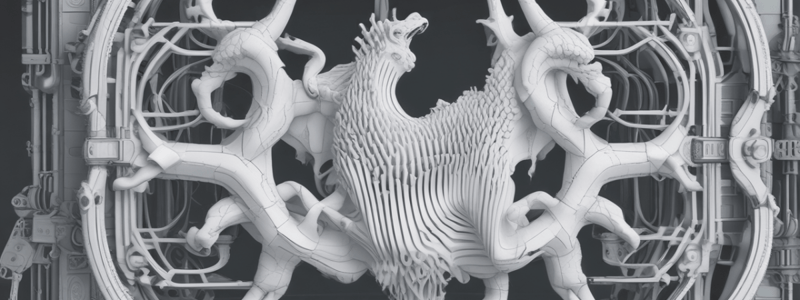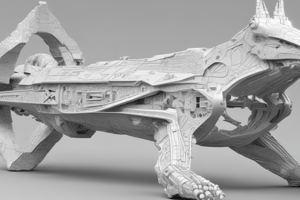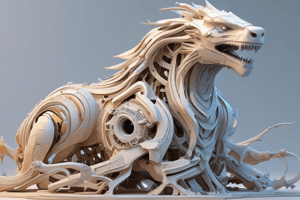Podcast
Questions and Answers
What is the primary classification of Rapid Prototyping Systems based on?
What is the primary classification of Rapid Prototyping Systems based on?
What is the process used to convert liquid into solid state in liquid-based RP systems?
What is the process used to convert liquid into solid state in liquid-based RP systems?
What is the material used in Laminated Object Manufacturing (LOM) prototyping technology?
What is the material used in Laminated Object Manufacturing (LOM) prototyping technology?
What is the type of laser used in the Laser Engineered Net Shaping (LENS) process?
What is the type of laser used in the Laser Engineered Net Shaping (LENS) process?
Signup and view all the answers
What is the environment in which the fabrication process takes place in the LENS process?
What is the environment in which the fabrication process takes place in the LENS process?
Signup and view all the answers
What is the primary purpose of the motion system in the LENS process?
What is the primary purpose of the motion system in the LENS process?
Signup and view all the answers
What is the purpose of tilting the object/cluster by 10 to 15 degrees in LOM, SLS, SGC, and 3D printing?
What is the purpose of tilting the object/cluster by 10 to 15 degrees in LOM, SLS, SGC, and 3D printing?
Signup and view all the answers
What is the primary function of the hot roller in the LOM process?
What is the primary function of the hot roller in the LOM process?
Signup and view all the answers
What is a major limitation of the LOM process?
What is a major limitation of the LOM process?
Signup and view all the answers
What is the primary difference between 3D printing and SLS?
What is the primary difference between 3D printing and SLS?
Signup and view all the answers
What is the function of the nozzle in FDM?
What is the function of the nozzle in FDM?
Signup and view all the answers
Why are explicit support structures required in FDM?
Why are explicit support structures required in FDM?
Signup and view all the answers
What is a major advantage of the LENS process?
What is a major advantage of the LENS process?
Signup and view all the answers
What is a limitation of the DMD process?
What is a limitation of the DMD process?
Signup and view all the answers
What is a benefit of the DLD process?
What is a benefit of the DLD process?
Signup and view all the answers
What is a drawback of building overhang parts using traditional DLD or RP processes?
What is a drawback of building overhang parts using traditional DLD or RP processes?
Signup and view all the answers
What is a challenge of the 'Cut and then paste' approach in LOM?
What is a challenge of the 'Cut and then paste' approach in LOM?
Signup and view all the answers
What is an advantage of the 'Paste and then cut' approach in LOM?
What is an advantage of the 'Paste and then cut' approach in LOM?
Signup and view all the answers
What is the primary goal of companies in the current marketplace?
What is the primary goal of companies in the current marketplace?
Signup and view all the answers
What is a prototype?
What is a prototype?
Signup and view all the answers
What is the term 'rapid prototyping' referring to?
What is the term 'rapid prototyping' referring to?
Signup and view all the answers
What are alternative names for Rapid Prototyping?
What are alternative names for Rapid Prototyping?
Signup and view all the answers
What is the main difference between traditional prototyping and rapid prototyping?
What is the main difference between traditional prototyping and rapid prototyping?
Signup and view all the answers
What is the main advantage of rapid prototyping over traditional prototyping?
What is the main advantage of rapid prototyping over traditional prototyping?
Signup and view all the answers
What is the primary method of depositing material in the Fused Deposition Modeling process?
What is the primary method of depositing material in the Fused Deposition Modeling process?
Signup and view all the answers
What is a major advantage of Fused Deposition Modeling over other RP processes?
What is a major advantage of Fused Deposition Modeling over other RP processes?
Signup and view all the answers
What is a limitation of Electron Beam Melting (EBM) compared to other Powder Bed Fusion (PBF) processes?
What is a limitation of Electron Beam Melting (EBM) compared to other Powder Bed Fusion (PBF) processes?
Signup and view all the answers
What is the primary difference between Electron Beam Melting (EBM) and other Powder Bed Fusion (PBF) processes?
What is the primary difference between Electron Beam Melting (EBM) and other Powder Bed Fusion (PBF) processes?
Signup and view all the answers
What is the purpose of the small mirror in the Selective Laser Sintering (SLS) process?
What is the purpose of the small mirror in the Selective Laser Sintering (SLS) process?
Signup and view all the answers
Why is it not necessary to use explicit support structures in Selective Laser Sintering (SLS)?
Why is it not necessary to use explicit support structures in Selective Laser Sintering (SLS)?
Signup and view all the answers
What is the purpose of using an inert environment in the selective laser sintering process?
What is the purpose of using an inert environment in the selective laser sintering process?
Signup and view all the answers
What is the advantage of using selective laser sintering over other rapid prototyping techniques?
What is the advantage of using selective laser sintering over other rapid prototyping techniques?
Signup and view all the answers
What is the purpose of copper impregnation in the selective laser sintering process?
What is the purpose of copper impregnation in the selective laser sintering process?
Signup and view all the answers
What is the limitation of selective laser sintering in terms of surface finish?
What is the limitation of selective laser sintering in terms of surface finish?
Signup and view all the answers
What is the purpose of the small mirror in the stereo lithography process?
What is the purpose of the small mirror in the stereo lithography process?
Signup and view all the answers
What is the purpose of the post-cure apparatus in the stereo lithography process?
What is the purpose of the post-cure apparatus in the stereo lithography process?
Signup and view all the answers
What is the pattern used for area filling in the stereo lithography process?
What is the pattern used for area filling in the stereo lithography process?
Signup and view all the answers
What is the purpose of the contra-rotating roller in the selective laser sintering process?
What is the purpose of the contra-rotating roller in the selective laser sintering process?
Signup and view all the answers
What is the advantage of using stereo lithography over other rapid prototyping techniques?
What is the advantage of using stereo lithography over other rapid prototyping techniques?
Signup and view all the answers
What is the purpose of the support structures in the stereo lithography process?
What is the purpose of the support structures in the stereo lithography process?
Signup and view all the answers
Study Notes
Introduction to Rapid Prototyping
- Rapid prototyping (RP) is a class of technologies that create physical models from Computer-Aided Design (CAD) data.
- Alternative names for RP include Additive Manufacturing, Layer Manufacturing, Direct CAD Manufacturing, and Solid Freeform Fabrication.
Traditional Prototyping vs. Rapid Prototyping
- Traditional prototyping involves building a model from clay, carving from wood, bending wire, or using thermoplastic, photopolymer, metals, paper, or titanium alloys.
- Traditional prototyping methods are time-consuming, lack quality, and cannot effectively evaluate alternative design concepts.
- Rapid prototyping methods are faster, more accurate, and can effectively evaluate design concepts.
Classification of Rapid Prototyping Systems
- RP systems can be classified into three categories: liquid-based, solid-based, and powder-based.
Liquid-Based RP Systems
- Liquid-based RP systems include:
- 3D Systems' Stereo lithography Apparatus (SLA)
- Cubital's Solid Ground Curing (SGC)
- Sony's Solid Creation System (SCS)
- CMET's Solid Object Ultraviolet-Laser Printer (SOUP)
- Autostrade's E-Darts
- Teijin Seiki's Soliform System
- Meiko's Rapid Prototyping System for the Jewelry Industry
- Denken's SLP
- Mitsui's COLAMM
- Fockele & Schwarze's LMS
- Light Sculpting
- Aaroflex
- Rapid Freeze
- Two Laser Beams
- Micro fabrication
Additive Manufacturing Techniques
-
- Laser Engineered Net Shaping (LENS)
- Builds components in an additive manner from powdered metals using a Nd:YAG laser.
- Produces fully dense metal parts with good metallurgical properties.
- Advantages: superior material properties, complex parts, and reduced post-processing requirements.
- Disadvantages: limited materials, large physical unit size, and high power consumption.
-
- Direct Metal Deposition (DMD)
- Uses a laser to weld air-blown streams of metallic powders into custom parts.
- Can produce fully dense metal parts with good metallurgical properties.
- Advantages: ability to fabricate fully dense metal parts, efficient, and reduces production costs.
- Disadvantages: limited to building overhang parts and requires support structures.
-
- Sheet Lamination (Laminated Object Manufacturing (LOM)
- Builds parts by laminating layers of paper or other materials.
- Advantages: fast, inexpensive, and ideal for patterns for casting.
- Limitations: grid cutting takes time, decubing is time-consuming, and horizontal surfaces pose problems.
-
- 3D Printing
- Similar to SLS, except that a binder liquid is sprayed in selected regions.
- Can use a wide variety of powders.
- Advantages: fast, inexpensive, and ideal for concept models.
- Limitations: requires sintering, and supports are required.
-
- Fused Deposition Modeling (FDM)
- Uses molten material to build parts.
- Advantages: uses any thermoplastic material, easy to remove support, and inexpensive.
- Limitations: slow, not very accurate, and requires explicit support structures.
-
- Electron Beam Melting (EBM)
- Uses an electron beam to induce fusion between metal powder particles.
- Advantages: fast, efficient, and can process conductive materials.
- Limitations: can only be used with conductive materials, and has a larger heat-affected zone.
-
- Selective Laser Sintering (SLS)
- Uses a laser to fuse together metal powder particles.
- Advantages: fast, uses a wide variety of powders, and ideal for making injection molding tools.
- Limitations: surface finish is poor, and Z accuracy is poor.
-
- Photopolymerization (Stereo Lithography (SLA)
- Uses a laser to polymerize liquid photopolymer.
- Advantages: fast, accurate, and ideal for making prototypes.
- Limitations: requires explicit support structures, and post-processing is required.
Studying That Suits You
Use AI to generate personalized quizzes and flashcards to suit your learning preferences.
Description
Learn about the basics of additive manufacturing, rapid prototyping, and its applications, limitations, and classification. Compare traditional prototyping with rapid prototyping.





